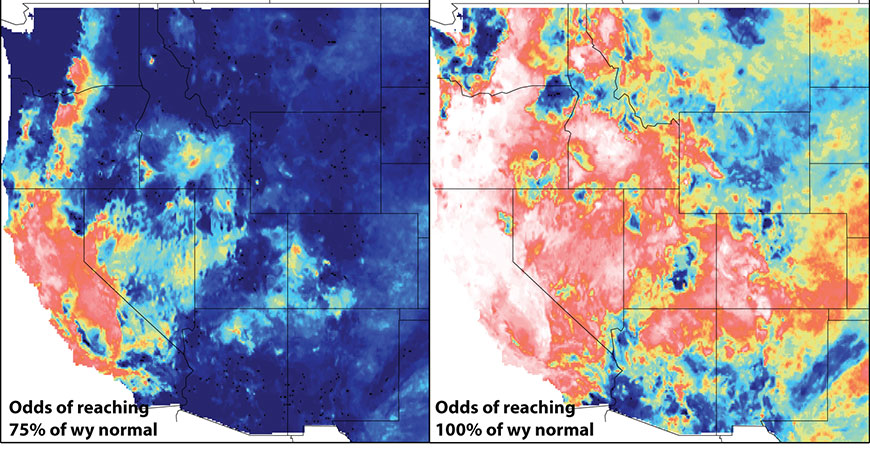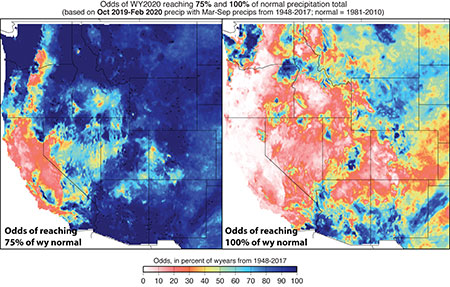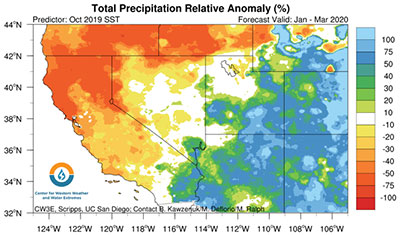| 正文(英文) |
 Forecast map for the current year ending Sept. 30. Image: Mike Dettinger/CW3E
Recent rains giving San Diego a late-season soak have brought the tally for all Southern California up to more than 70 percent of its yearly average, but statewide there remains a larger deficit, said climate scientists at Scripps Institution of Oceanography at UC San Diego.
The flurry is out of the ordinary, said scientists, since most of Southern California’s storminess and accompanying natural water delivery usually occurs between December and February.
The state overall still has received less than half its normal rain and snow amounts with the wet season coming to a close. Despite a stormy week throughout much of California, northern Sierra Nevada precipitation crucial for state water supply is still mired at 42 percent of wet season expectations. Snow water storage is around 50 percent in key watersheds, according to the latest data, including that from the Scripps Oceanography-led California Nevada Applications Program.
Another storm expected next week could help the Sierra water picture improve, but not enough to drive the region out of substantial deficit, said Scripps Oceanography climate scientist Dan Cayan.
Other calculations based on 72 years of records suggest Northern California has less than a one-in-three chance of reaching even 75 percent of normal this water year, which ends Sept. 30. The estimate does not factor in the wet period over the last week, however, said researchers.
During that week, some locations in the Sierra received a boost to snowpack, including snow depth increasing by over five feet, nearly doubling the snowpack that was there. That increase represented about 20 percent of snow that would fall during an entire winter at that site. Many Sierra sites received 10 percent of the annual average during that same few-day period.
If nothing else, overall, this water year is bearing out predictions made by the Center for Western Weather and Water Extremes (CW3E) at Scripps. The forecast was issued last fall for the period from January through March 2020.
“Based on Pacific Ocean surface temperature patterns, we had forecast anomalously dry conditions in the north and central parts of California and wet in the southeast,” said Scripps Oceanography scientist Alexander Gershunov.
Another new forecast tool, which was developed jointly by CW3E and NASA’s Jet Propulsion Laboratory, was launched by CW3E this winter. It processes outputs from the nation’s leading global weather prediction model run by the National Weather Service. The tool focuses on the West Coast landfall of atmospheric river storms, which are key to California water supply and snowpack. It predicts the odds of atmospheric rivers making landfall at lead times of one to three weeks. The tool presaged the wet period last week, which included a weak atmospheric river.
Additionally, the same weather model currently calls for more rain in Southern California this week and a chance for lighter rainfall next week. Northern California is also predicted to receive more rain and snow in the next 10 days.
Note to broadcast and cable producers: University of California San Diego provides an on-campus satellite uplink facility for live or pre-recorded television interviews. Please phone or email the media contact listed above to arrange an interview.
About Scripps OceanographyScripps Institution of Oceanography at the University of California San Diego, is one of the oldest, largest, and most important centers for global science research and education in the world. Now in its second century of discovery, the scientific scope of the institution has grown to include biological, physical, chemical, geological, geophysical, and atmospheric studies of the earth as a system. Hundreds of research programs covering a wide range of scientific areas are under way today on every continent and in every ocean. The institution has a staff of more than 1,400 and annual expenditures of approximately $195 million from federal, state, and private sources. Scripps operates oceanographic research vessels recognized worldwide for their outstanding capabilities. Equipped with innovative instruments for ocean exploration, these ships constitute mobile laboratories and observatories that serve students and researchers from institutions throughout the world. Birch Aquarium at Scripps serves as the interpretive center of the institution and showcases Scripps research and a diverse array of marine life through exhibits and programming for more than 430,000 visitors each year. Learn more at scripps.ucsd.edu and follow us at Facebook, Twitter, and Instagram. About UC San DiegoAt the University of California San Diego, we embrace a culture of exploration and experimentation. Established in 1960, UC San Diego has been shaped by exceptional scholars who aren’t afraid to look deeper, challenge expectations and redefine conventional wisdom. As one of the top 15 research universities in the world, we are driving innovation and change to advance society, propel economic growth and make our world a better place. Learn more at www.ucsd.edu.
|








修改评论